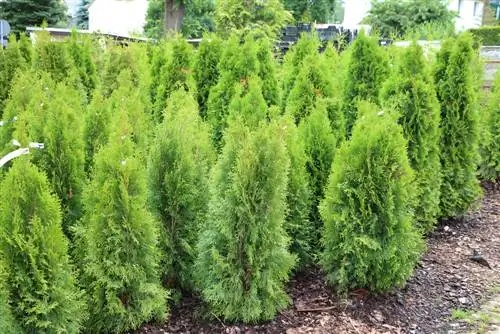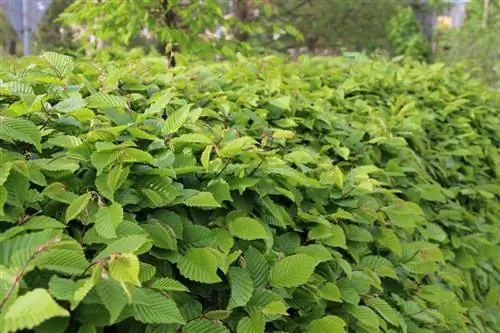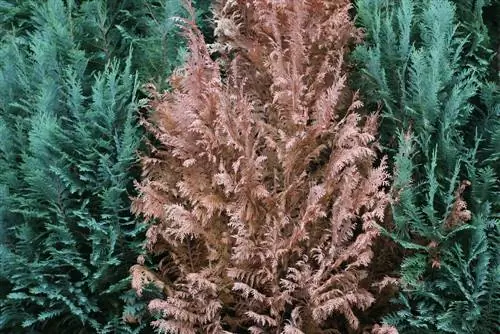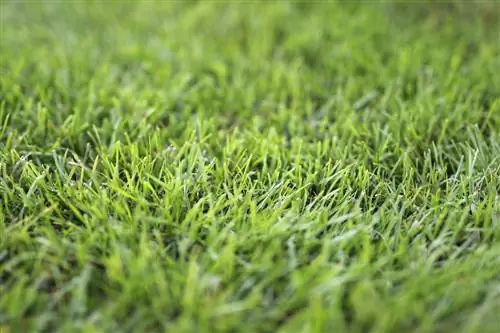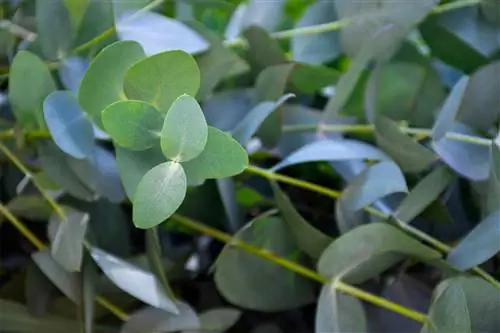- Author admin [email protected].
- Public 2023-12-17 03:39.
- Last modified 2025-01-24 12:45.
Whether as a living enclosure or as a privacy screen, the thuja is very popular with us. However, the dense growth of the tree of life is no coincidence. Only with an optimal supply of nutrients will it thrive the way we want it to. To ensure that the nutrient supply is seamless, we will explain to you below functional fertilizers other than ready-made chemical preparations.
When is fertilization done?
Although the thuja depends on a good nutrient composition, you should neither fertilize excessively nor too frequently. In general, the plant is viewed as rather undemanding and only slightly consuming of the soil substrate. In the following circumstances, it is also worth supplying nutrients via proven fertilizers in order to provide the tree of life with the best possible support:
- Young plants shortly after or with planting
- bare-rooted seedlings after two to three weeks (due to the formation of root hairs for nutrient absorption)
- " adult" Thujen if there are signs of undersupply, such as patchy growth, yellowing of the leaves or generally reduced growth
Tip:
Whether you use complete fertilizer or home remedies, approach the amount of fertilizer carefully. If in doubt, give too little fertilizer and add fertilizer later. The thuja has difficulty coping with too high a dose of nutrients and responds with brown and dry shoots.
Compost
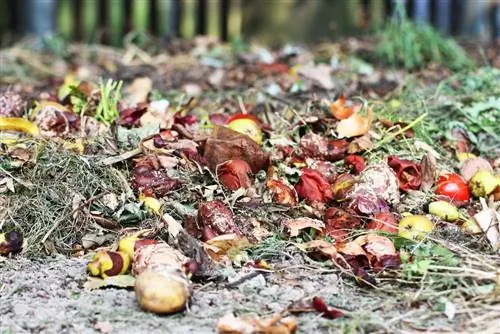
Compost can be found in almost every garden. Over time, microorganisms from earthworms to microorganisms form loose, nutrient-rich soil - compost - from green waste, plant remains from the previous year or even kitchen waste. Depending on the source materials, the ingredients may vary.
Ingredients
- Nitrogen
- Potassium
- calcium
- Magnesium
- Phosphate
- Various other, slightly varying minerals
Operation
- Sifting compost
- approx. Sprinkle two fingers loosely on the soil
- rake carefully or pull in with a rake
- Lightly pour over dry compost for better nutrient release and protection from burning the fine root hairs
Alternative
For new plantings, place under the root ball in the planting hole
Tip:
Another advantage of compost is the humus it contains. This stores water very well and serves as an additional water reservoir for the Thuja. The plants that require a lot of moisture are happy to accept this additional offer.
Lauberde
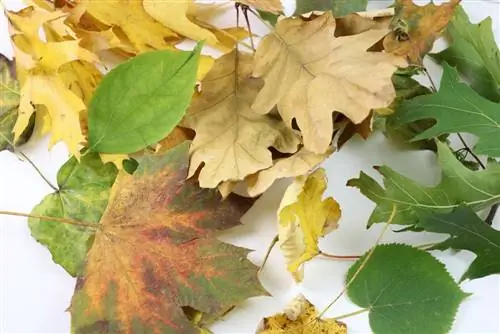
Leaf soil is a special variant of normal compost. This is ultimately also a variant of compost, but is mainly made from the fallen leaves of trees. As a “starter” and basis for the necessary microorganisms, just a little finished garden compost is added. Added lawn clippings also provide nitrogen. To prevent acidification, additional lime can be incorporated in layers.
Ingredients
- Nitrogen
- Potassium
- calcium
- Magnesium
- Phosphorus
- other minerals and trace elements
Operation
- Sift leaf soil until finely crumbly after decomposition is complete
- apply on soil in a layer about two fingers thick
- work in with a rake or garden rake
Alternative
Pour into the planting hole when planting or mix the filling soil proportionately with leaf soil
Tip:
Leaf soil takes significantly longer to mature, around two years, than other decomposing fertilizers. But it is a good way to use up autumn leaves. It also offers a very comprehensive nutrient complex, so that additional substances are hardly necessary.
Crap
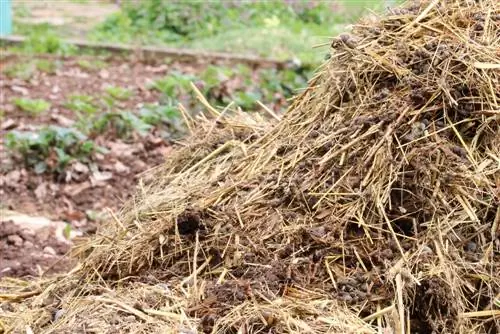
As the animal counterpart to compost, manure - i.e. the mixture of animal feces and the straw used as bedding in the stable - also offers a wide range of beneficial ingredients. It is particularly often recommended to use horse manure. Due to the horses' rather one-sided diet of grass and hay, it has a very consistent quality and has a particularly high mineral content. Goat or pig manure in particular should only be used in exceptional cases, as the animals' very variable diet has a strong influence on the composition of the manure.
Ingredients
- Potassium
- Nitrogen
- Phosphate
Operation
- Sprinkle manure loosely on soil
- work in with digging fork or rake
- water lightly if necessary
Alternative
For new plantings, place under the root ball in the planting hole
NOTE:
Depending on the length of storage, the nutrient content of horse manure decreases steadily. However, as decomposition progresses, the other soil-improving properties increase. Depending on your personal needs, it may therefore make sense to first store the manure for a while and only then use it as fertilizer.
Horn shavings
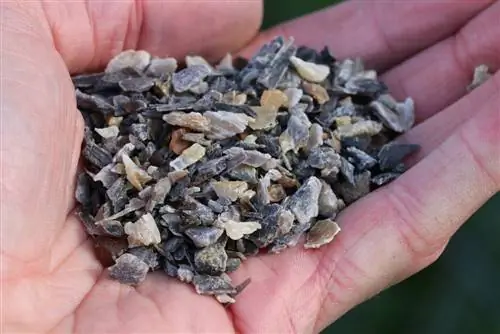
Horn shavings are small horn particles that are obtained from the horns and hooves of slaughtered cattle. Either easily recognizable particle sizes are used as so-called horn shavings, or finely ground horn meal. The only difference between the two substances is the degree of grinding and therefore the speed at which the ingredients are absorbed into the soil. The finer, the faster.
Ingredients
- Nitrogen (very high levels)
- Phosphorus
- calcium
Operation
- Sprinkle horn meal or shavings loosely over the soil in the root area
- work easily with a rake
- water well and wash into the ground
Note:
Although horn shavings provide some of the essential plant nutrients, they are nowhere near the range of other decomposition products, such as manure or compost. They are therefore primarily used as a nitrogen supplement to more comprehensive fertilizers.
Epsom S alt

Chemically correct, this s alt is called magnesium sulfate. Therefore, it only contains the two nutrients important for plants: magnesium and sulfur. Since magnesium is of enormous importance for photosynthesis in plants, the use of Epsom s alt makes sense, but cannot replace complete fertilizer. Epsom s alt is often even integrated into commercially available complete fertilizers as a component of the supply.
Operation
Sprinkle s alt on soil and pour in
Alternative
Mix into compost, manure or other natural fertilizers and administer together with these
Tip:
Magnesium deficiency occurs in thujas primarily on acidic, sandy soils and is indicated by brown shoot tips. If a magnesium deficiency is suspected, it is still worth determining the soil value to avoid incorrect supply.
Coffee grounds
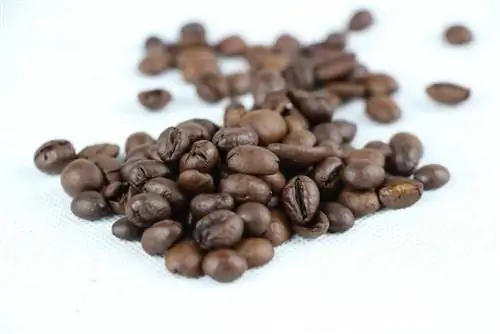
Admittedly, coffee grounds are rarely used as the sole fertilizer, especially for large thuja populations, for reasons of availability. If it is added to the soil when it is available, it can have a positive effect on the tree of life thanks to the nitrogen it contains and its slightly acidic properties.
Ingredients
- Nitrogen
- other minerals in moderate amounts
Operation
- Put used coffee powder on the ground and fold in loosely
- pour lightly to dissolve ingredients through moisture
ATTENTION:
You should distribute the usual household coffee grounds alternately and evenly to all your thuja plants. Because even this byproduct can make the soil acidic if administered too intensively. This can be recognized, for example, by black needle tips.
Rock flour
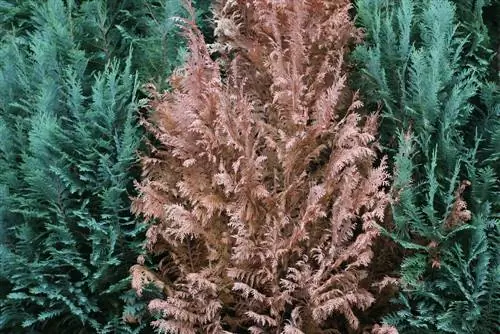
As the only mineral representative of natural fertilizers, finely ground rock is able to provide your Thuja with numerous minerals. The composition can vary depending on the rock, but what they all have in common is the absence of nitrogen, which can only be found in organic fertilizers.
Ingredients
- Magnesium
- calcium
- Iron
- Potassium
- Silica
- Trace minerals, such as molybdenum and manganese
Operation
- Sprinkle rock dust and calculate it
- wash into soil by watering

